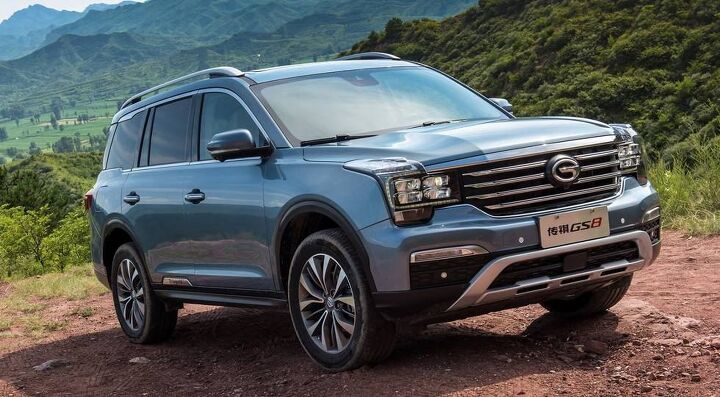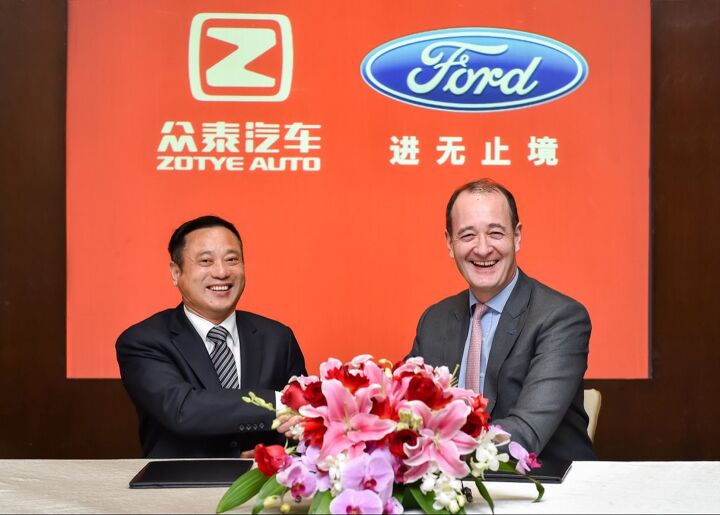#China
Here's What Chinese Brand GAC Still Needs to Do to Get Into America
Chinese car brand Guangzhou Automobile Group’s showing at the North American International Auto Show made it pretty clear that the manufacturer wants to get into the U.S. market. But, with its earlier deadlines to do so having gone unmet, there is skepticism that it won’t happen by 2019. Is it really possible?
Well, sure, anything is possible. But GAC has a laundry list of obstacles to overcome if it wants to sell cars to Americans in earnest and the clock is ticking. For starters, politicians are starting to get a little testy when it comes to Chinese trade policies, and GAC now finds itself as a focal point on the issue. More importantly, the brand needs a clear-cut path to victory — and we’ve yet to hear one.
The GAC Effect: Imported Chinese Automobiles Face Fierce Criticism From U.S. Politicians
At this very moment, Chinese-based automaker GAC has a massive booth in the very center of the North American International Auto Show in Detroit. The company has expressed its intent to start importing its vehicles into the United States in 2019. However, 536 miles away (by car), Washington is bemoaning Chinese trade practices — a topic which might be extremely relevant for Guangzhou Automobile Group in the coming years.
On Wednesday, Democratic U.S. Senator Chuck Schumer and President Donald Trump separately criticized China’s trade policy. For automobiles, this translates into Chinese-built cars incurring a maximum 2.5 percent import tariff upon entering the United States, while U.S.-built cars sent East are hit with an average 25 percent tax.
We're Not Offloading Any Brands to China: Fiat Chrysler CEO
Last year, following several fruitless attempts to find a merger partner, Fiat Chrysler Automobiles found itself on the business end of a pretty shocking rumor. Apparently, several Chinese automakers were lining up for a chance to buy FCA. Not so, said those automakers, though Great Wall Motors mentioned it totally wouldn’t miss a chance to steal the Jeep brand away from its parent.
While the thought of such an acquisition no doubt inspired nightmares among Jeep fans (and FCA accountants), it was not to be. Not only is the automaker determined to keep a firm hold on its most valuable brand, it’s not planning on offloading any division, CEO Sergio Marchionne now claims.
QOTD: When Will All of Our Cars Be Chinese?
When Henry Ford began selling his popular Model T around the world, the company bearing his name didn’t assemble all of them in America. Instead, the Model T was the first truly global car, assembled in Commonwealth nations such as England, Canada, Australia, and others like Argentina, Belgium, Brazil, Denmark, France, Germany, Mexico, Norway, Spain — hell, even Japan.
But that was a different time. Regardless of which country someone lived in, Ford factory workers made roughly the same amount of money working on the assembly line.
Now things are different.
Depressed About Flat U.S. Car Sales and the Death of the Sedan? Will 90 Million Units Globally Cheer You Up?
While it’s definitely not the same doom and gloom vibe felt around the domestic auto industry as it was financially circling the drain in 2008, headlines in the new year seem to forecast storm clouds on the horizon.
After nearly a decade of sales growth, the American market for passenger cars and light trucks flattened out in 2017. Actually, sales didn’t just flatten in the U.S., they dropped 1.75 percent for the year. Not only has the overall U.S. market shrunk, we’re seeing predictions of the death of an entire segment of that market, the sedan — a segment that has pretty much defined the American automotive world for a century. It’s one thing for an iconoclastic website like TTAC to be talking about a sedan deathwatch, but when that prediction is on the front page of the Detroit News, with reports that Ford may very well stop building sedans in America and that Buick sedan sales have been cut in half over the past year, people will take notice.
I’m not here to depress you, though. Despite the gloomy cast to things, in reality the automotive industry as a whole is doing very well.
Faraday Future CEO Defies Order to Return to China
Founder of the debt-laden technology firm LeEco has shirked orders from Chinese authorities to return to the country before the end of 2017, saying he needed to stay within the United States to fundraise for Faraday Future. Last week, the Beijing branch of the China Securities Regulatory Commission issued a notice ordering Jia Yueting to return to China to face the staggering debt attached to his various businesses and protect investors’ rights.
However, he claims he’s making too much headway with efforts to keep electric vehicle startup Faraday Future from sinking deeper into the toilet to head back to China. Instead, he has requested that his brother, Jia Yuemin, meet the regulator face-to-face last Friday to provide a report in response to the notice.
When Will We See Chinese Cars On North American Roads?
It seems like we’ve been hearing about it forever — that fateful day when China surpasses the United States by every single metric imaginable and forces everyone to drive its cars. While that premonition has already come to pass in some respects, there’s still no overtly Chinese automobiles milling around on North American roads.
However, manufacturers from The People’s Republic have been looking westward for a decade. I can recall BYD Auto, along with other Chinese firms, having a booth in the basement of the North American International Auto Show way back in 2008. They weren’t there because they had nothing better to do — they were there to size up the competition and let America know they were coming. Of course, nothing happens overnight and Chinese automakers have been a little busy converting their domestic market into the world’s largest. But the time for westward expansion is fast approaching.
Have You Driven a Lately? Production of Ford Fusion May Move to China
It’s no secret that the American buying public shuns four door sedans as if they were an especially virulent leper. Through the first 11 months of this year, the segment is off by over 300,000 units. Almost every car is down, even the spanking-new Honda Accord and Toyota Camry.
Reuters now reports that three of its sources claim Ford plans to consolidate global production of midsize sedans in 2020. The cars will be built in China and shipped to the United States and Europe.
World Domination: NEVS Re-launches 9-3 EV in China, Swedish Production Planned for Next Year
The Saab 9-3 has to have one of the strangest histories of any automobile ever to reach mass production. Intended as a replacement for the 900, the model used a pair of GM-based platforms split between two generations before dying out when Saab went bankrupt in December of 2011.
The company’s assets were purchased by National Electric Vehicle Sweden the following year. NEVS spent the following years attempting to relaunch the 9-3 as an all-electric vehicle. Despite multiple occasions where it seemed like the project had stagnated into oblivion, the firm actually started assembly on a rebadged 9-3 EV sedan in Tianjin, China, this December.
Now the company is saying it intends to expand production to Saab’s vintage factory in Trollhättan, Sweden, while also considering adding additional facilities in China and Turkey. Who could have imagined that the world’s next hot-ticket EV would be a model introduced in 2002 under a defunct nameplate?
Ford to Launch 50 New Vehicles by 2025… in China
Practically every automaker seeking to expand its global footprint is courting China right now. Ford Motor Company has already signed an agreement with Anhui Zotye Automobile to set up a $754 million joint venture focused on electric cars in the hopes it can get a head start on the country’s fast-approaching EV mandate.
With so much opportunity for growth, major manufacturers see Asia as a ripening market as North America withers on the vine. With that in mind, Ford has announced plans to launch 50 new vehicles in China by 2025.
Fiat Chrysler to Guangzhou: Swipe Right
Seven years ago, Fiat Chrysler Automobiles and China’s Guangzhou Automobile Group entered into a joint venture, forming a 50/50 partnership between the companies. Currently selling three locally produced Jeep models – the Cherokee, Renegade, and Compass – the JV also imports the Grand Cherokee and Wrangler. Last year, sales tripled to nearly 150,000 units.
Now, according to Automotive News, the parent companies are in discussions to deepen their tie-up in China. Talks are apparently focusing on models, production, and sales targets.
Volkswagen Sets Aside $11.8 Billion to Build EVs in China
When we were told the electric revolution was on its way, most of us probably assumed at least some of that vehicular renaissance would take place outside of China. But Asia is where all the hot EV action lives, so that’s where the money goes.
Volkswagen, now promising one of the industry’s most ambitious pushes into electrification, plans to invest $11.8 billion through 2025 to develop and manufacture all-electric and plug-in hybrid vehicles in China, as the nation’s emission mandates become progressively more stringent.
QOTD: How Can I Get You Into a Chinese Car Today?
It’s no use continuing with the idealistic notion that North America will reject advances from Chinese-made cars on our shores. The Buick Envision is Fabrique en Chine, as well as the long-wheelbase Volvo S60, and more recently the Volvo S90. Yesterday, Steph Willems reported on a patent filing from the Guangzhou Automobile Company for its largest SUV offering, the GS8.
You don’t have to like the upcoming Chinese onslaught, but it’s necessary to accept it as reality. So, today we’re asking you to twist your mind and wring from it your thoughts on what it would take for a Chinese auto manufacturer to be successful in North America on a large scale.
What Does This Design Patent Mean for America?
It may look like a strange amalgam of Ford and General Motors styling cues, maybe with a dash of something else (Nissan?), but the model in the image you see above is no mystery. And it’s certainly not domestic.
The United States Patent and Trademark Office bestowed a design patent on a certain automaker today and, while the model isn’t named, we know exactly what it is. Does this Trumpchi get your vote?
Ford Joins Forces With Zotye to Build Baby-sized Electric Cars for China
In August, Ford began exploring a possible joint venture with Chinese automaker Anhui Zotye to build electric vehicles in China. While we didn’t know what they would be building exactly, sales of battery-only and gasoline-electric hybrids in China rose by 50 percent last year to roughly 336,000 deliveries — odds were good that whatever came of the team-up would remain in Asia.
Then, on Wednesday, the two companies reached an agreement. Ford and Zotye have greenlit a $756 million joint venture for the creation of an entirely new brand focused on small EVs. The vehicles will probably be among the most petite Ford will offer in Asia, as it has already committed itself to shifting at least 70 percent of Ford-branded vehicles sold in the country to electrified powertrain by 2025. The new brand will also produce “city cars” as its primary stock.





























Recent Comments